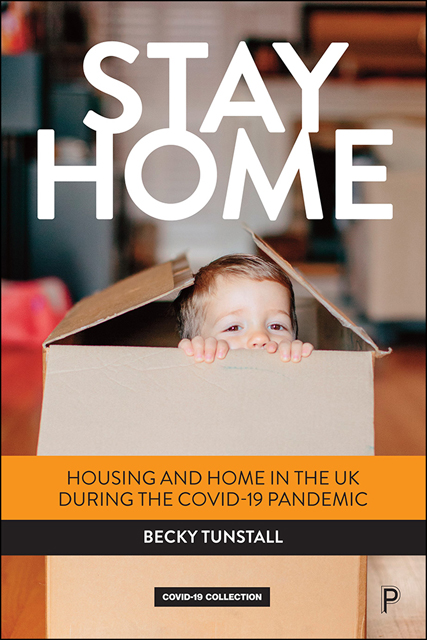Book contents
- Frontmatter
- Contents
- List of figures, tables and photos
- Acknowledgements
- 1 COVID-19, housing and home
- 2 UK households and homes before the pandemic
- 3 The pandemic and pandemic policy in the UK
- 4 People, households and time at home in the pandemic
- 5 The role of household and home in COVID-19 infection and death
- 6 Being vulnerable or ill at home in the pandemic
- 7 The impact of COVID-19 and COVID-19 policy on incomes, housing costs and housing security
- 8 The impact of COVID-19 and COVID-19 policy on the housing market
- 9 Summary and conclusions
- Appendix: The data from people aged 19, 31, 50, 62 and 74
- Notes
- References
- Index
4 - People, households and time at home in the pandemic
Published online by Cambridge University Press: 20 June 2023
- Frontmatter
- Contents
- List of figures, tables and photos
- Acknowledgements
- 1 COVID-19, housing and home
- 2 UK households and homes before the pandemic
- 3 The pandemic and pandemic policy in the UK
- 4 People, households and time at home in the pandemic
- 5 The role of household and home in COVID-19 infection and death
- 6 Being vulnerable or ill at home in the pandemic
- 7 The impact of COVID-19 and COVID-19 policy on incomes, housing costs and housing security
- 8 The impact of COVID-19 and COVID-19 policy on the housing market
- 9 Summary and conclusions
- Appendix: The data from people aged 19, 31, 50, 62 and 74
- Notes
- References
- Index
Summary
The impact of COVID on the size of the population
Births: an acceleration of a downward trend
Between January and September 2020, there were 464,000 live births in England and Wales. This was a reduction of 17,000 live births or 3.6% when compared to the same nine-month period in 2019. There has been a long-term decline in annual numbers of live births in the UK, despite the rising total population, since at least 2011. However, the reduction between 2019 and 2020 was larger than the reduction any year except 2013 (when population fell by 23,000 between January and September).
Deaths: an increase
Over the pandemic period, death rates have increased, with deaths due to COVID-19 and other excess deaths (see Figure 3.4). From January 2020 to January 2021, the average weekly age-standardised death rate for the UK was 7.9% above average, 8.5% for England, 5.8% for Scotland, 5.7% for Northern Ireland and 5.3% for Wales.
International migration: a change in trend
Aburto et al said: ‘Measuring migration flows is always a challenge, and the picture has become even more murky during the pandemic.’ Nonetheless, there seems to have been a significant change in trend. Foreign-born and non-UK citizen populations grew continuously between 2008 and 2017, and then stablished between 2017 and 2019. However, the UK’s non-UK citizen population dropped by 231,000, a reduction from 9.4% of the total population in 2018/19 to 9.0% in 2019/20. The foreign-born population also fell by 240,000, from 14.3% of the total in 2018/19 to 13.8% in 2019/20. The change is likely to be due mainly to out-migration, although acquisition of citizenship could have played a small role. Change was concentrated in England, in London, among people with citizenship of newer EU Member States, and who had migrated to the UK for work. The change is likely to be partly due to Brexit, which officially took place on 31 January 2020 (see Chapter 2), and partly due to disruption to work and life caused by COVID-19.
The impact of COVID-19 on the number, size and shape of households
Changes in the numbers and types of households
The number of households in the UK decreased from 27,824,000 in 2019 to 27,792,000 in 2020, or by 0.1%.
- Type
- Chapter
- Information
- Stay HomeHousing and Home in the UK during the COVID-19 Pandemic, pp. 55 - 80Publisher: Bristol University PressPrint publication year: 2022



